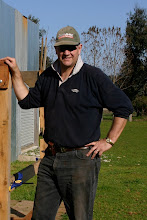S
I've been very busy. Too much of it in the City, but that is what pays the bills.There is a website in Australia that is a bit like Google Earth, but better. It's a website based system accessed at www.nearmap.com. Here is a screen shot taken from a photo taken 21 October this year. I hope I'm not breaching any agreement by putting this on the blog.
The photo shows 4 of my paddocks. Starting bottom right and going clockwise, we go 41, 42, 43 and 44. The photo shows the pattern of use.
Paddock 43 (top left) was mulch mown in May because I'd not been able to get to grazing last season. In late July when it was very wet I thought this paddock might be good being the highest on the farm. Not true - it seems to hold the rain and the cows hooves were going in 4 inches. So the mulched grass got well incorporated into the paddock. I put the whole herd back in there for a few days in early October when it was again very wet. The photo shows the paddock 2 weeks later with just the slightest of green tinges starting.
When I looked at it today, I scored it at 5 on a scale where 10 equals the ideal next grazing point. I just checked and it's 49 days since last grazed - and I'm looking for a 100 day cycle. 43 is a Perennial Ryegrass paddock - which doesn't seem to be as good as my paddocks with Phalaris in the mix.
Paddock 44 (top right) is Phalaris - except for a strip around the edge. Don't ask how this happened, it just did. It was grazed from 6 September to 1 October and had a huge amount of feed as the break before grazing had been 242 days - albeit that included the winter. The cows calved in there - and the calves could hide in the long grass. You could be a few metres away and not see them - just an agitated Mum told you that you must be close.
There was so much feed in 44 that a certain amount of it wasn't used and just got trampled. 56 days after the cattle left it's already back to score 7 or 8. At the time the photo was taken the score was already about 3.
When the photo was taken one mob of cattle were in 41 (bottom right). They are at the western (left) end of the paddock. They are about to be shifted to the last area in the bottom right corner of the paddock. There was 3 days of grazing in the dark green bit for the 9.5 tonnes of cattle in there. They got through the paddock (another Ryegrass paddock) in 20 days.
The stripes you can see come from the compost and chicken manure spread last year. 41 was half done last year. 42 and 44 were fully done. 43 and the rest of 41 will get their turn this year. Other lines are where temporary electric fences have been.
The cattle are in 42 as I write. When the photo was taken, it had not been grazed for 60 days. The cows went in after 80 days but, as a Phalaris paddock, it was already pretty good. The score for the first few days grazing was 9, but we're now into an area where the Phalaris is about 4 feet high and I score it at 12. I'm feeding a 80 metre strip 4 or 5 metres at a time. That way the cattle seem to graze the tops with their butts on yesterday's area, then work their way down the stem - without the plant trampling they do with a wider break.
The way I work out how much the mob gets each day is I multiply the square metres by the pasture score and give them about 70% as many pasture units as there are kilograms of live weight. This is my version of Joel Salatin's cow days. The feedback is pretty good though - you just have to look at how they did yesterday.
The pasture growth I am getting now is pretty fantastic. How much of it is just because, after many dry years, we've had 2 good years in a row? Surely some of it is the cell grazing - and the compost / chicken manure - and the paddock harrowing.
F





No comments:
Post a Comment